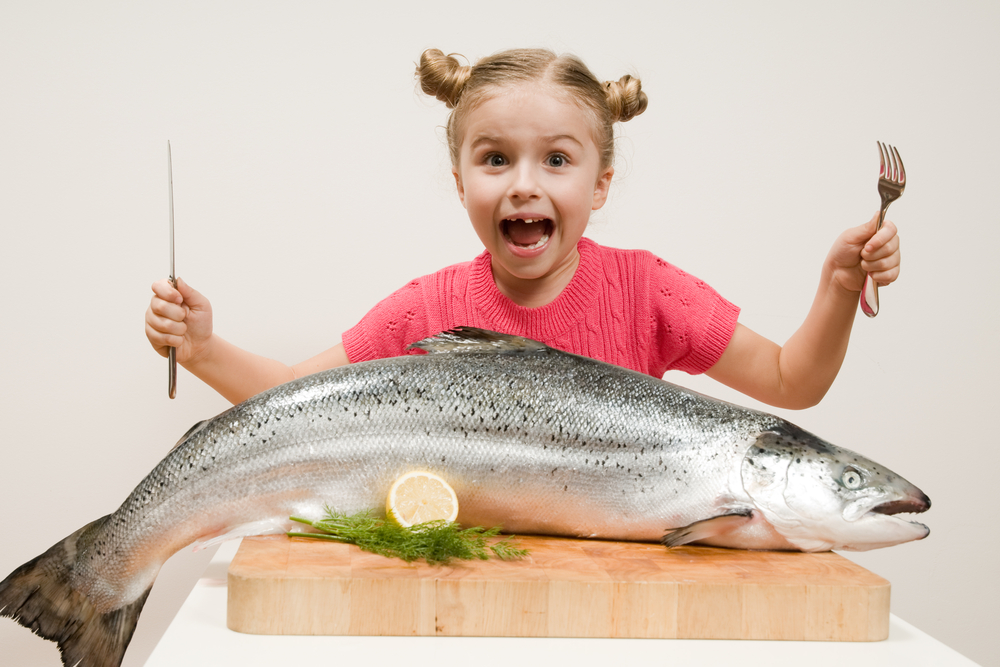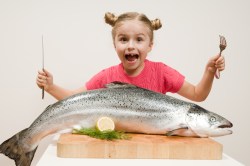Chicken and fish are often considered sort-of-not-really meat. You hear this a lot: “I don’t eat meat, but I eat chicken and fish.” Because they’re not mammals, the idea is, they’re not really animals.
I am as susceptible to this as anyone else. Also, I eat tons of chicken and fish. Probably a third of my at-home food intake is boneless chicken, and a third of my “eating out food” is fish. Not surprisingly, two weeks into not eating meat, I found that chicken and fish were my big cravings — as well as the foods I felt most inconvenienced not eating.
As I said when I began this experiment of not eating meat for six weeks, there’s only one way I’m not going to eat meat, and that is if I just don’t want to eat it. It’s one thing to know abstractly that there are all these reasons for not eating meat. It’s another to be tempted by the smell of roast chicken, or the sight of sushi — sitting cunningly on a small black plate, wasabi pal at its side. Appetites aren’t subtle.
Anyway, I needed to get grossed out. I needed to find out things about how chicken or fish were being treated that were cruel to the point of visceral horror — or to feel that, despite their pristine appearance under the plastic or on the plate, they were in fact unclean and potentially unhealthy.
I knew a good place to start for this would be Jonathan Safran Foer’s 2009 book Eating Animals. I am aware this is not the only book on how animals that become food live and die, and I’m also aware that the practices in commercial poultry farming and fishing I’ll be describing are not the only practices. (I’ll be discussing sustainable animal raising in later posts.) With those caveats, below are the most interesting, pertinent, horrifying pieces of information I got from Eating Animals about chicken and fish.
Chicken
- Chickens are generally raised in an area about the size of a piece of paper per chicken — at one farm Foer cites a number of 33,000 chickens in a room 45 by 490 feet long.
- The chicken slaughtering process has several steps. Chickens are picked up by their feet and stuffed into crates, which are then transported — sometimes in freezing cold — for slaughter. About 30 percent of all live birds arrive at the slaughterhouse with broken bones. Chickens are then hung up by their feet and dragged through an electrified bath so that they are not flapping around too much for the next step, which is to have their throats cut.
- The chickens are now placed in a scalding bath to remove their feathers and so on. Many of the chickens have defecated on themselves while being killed, and naturally, the feces go into the water. Hence the term “fecal soup,” popular among vegetarian activists, with good reason. A number of chickens will be slaughtered poorly and go into the scalding bath alive.
- There is a lot of information here about chickens and diseases. For the sake of brevity, I will cite Foer’s citing of Scott Bronstein’s series on poultry inspection for the Atlanta Journal-Constitution: “Every week millions of chickens leaking yellow pus, stained by green feces, contaminated by harmful bacteria, or marred by heart and lung infections, cancerous tumors, or skin conditions are shipped for sale to consumers.” (Yes, Bronstein’s original series dates back to the ’90s, but I’m going to assume that Big Chicken has not quietly done a u-turn in the interim.)
Fish
- Farmed fish are put in enormously crowded conditions. Breathing is difficult. Fish eat each other. There are tons of sea lice, and many fishes’ faces are eaten away by them. This is so common that it has a name: “the death crown.”
- If fish are caught on a long line — fisherman set thousands of hooked lines in the ocean and motor around between them, checking periodically — they can remain there for hours, dying from their wounds; or, defenseless, they are an easy mark for predators. Trawled fish — fish brought in from huge nets dragged through the ocean, often for hours –often suffocate in the net or are crushed. Those who do not die in this manner mostly suffocate on the deck of the ship. The last major method of catching fish is done with a net called a purse seine. Here’s Foer’s description: “A net wall is deployed around a school of target fish, and, once the school is encircled, the bottom of the net is pulled together … The trapped target fish and any other creatures in the vicinity are then winched together and hauled onto the deck. Fish tangled in the net may be slowly pulled apart in the process.” As with other methods of fishing, what happens next involves suffocation, or bleeding alive from cut gills, or a slow death in ice water.
- Fish that are not farmed obviously live “normal” lives prior to being caught, but when they are caught, death can be long. And there is a lot of evidence that fish feel pain. Foer cites this study. Here is one more.
The chicken thing is pretty simple and it’s all about two words: electrified bath. I don’t know how I made it 43 years without knowing about that, but now that I do know, I would have to be indulging in a pretty heavy act of abstraction to eat a commercially farmed chicken. I actually promised someone I would make them some chicken — I wasn’t even going to eat it, just make it — and I had to back out of that. Me and chicken are done. I saw some chicken today on a sandwich passing by me and I gagged. I wanted to turn to the person eating it and tell them about the electrified bath but I restrained myself. That said, (a) I would like to warn everyone I know that they are going to be hearing about the electrified bath in person and (b) I now know why some vegetarians seem humorless.
I found myself in tears reading about fish suffocating to death. I feel stupid writing that. And I even tried telling a few people about how it is that fish die when they are caught, or about how fish live when they are farmed, and I expected them to be horrified by it as well. But they all said the same thing: “They’re just fish.” (Believe me, I am not saying that these people are cruel and lack a sensitivity I somehow miraculously possess — I just think it’s interesting.)
Foer touches on how it is that we are able to decide, without really thinking about it much, that fish are somehow beneath us. People have justifications: Fish live in a different medium, fish have no expression in their eyes, fish are low on the evolutionary totem pole. All of this is true. Then Foer points out about how we would never take a hook to a dog’s face, but we think nothing of doing this to a fish. And then he asks this question: “Is the suffering of a drawn-out death something that is cruel to inflict on any animal that can experience it, or just some animals?”
According to the article Foer cites about fish feeling pain, it takes a fish about 14 minutes to suffocate to death. That seems very real to me, at this moment, and I feel quite certain, in this moment, I will never again eat fish.
It was very real to me a week ago, though, when I first read those words. And yet, three hours later, someone nearby me was eating some smoked salmon. And I wanted some. Still: I didn’t have any.




